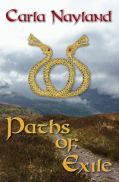The Invisible Woman: the story of Nelly Ternan and Charles Dickens, by Claire Tomalin. Book review
Penguin
1991. ISBN 978-0-140-12136-0. 283 pages
The Invisible Woman is a historical
biography of Ellen (Nelly) Ternan, a not-very-famous actress in Victorian
London who had a close relationship with the writer Charles Dickens for
thirteen years from 1857 to his death in 1870. It is also the story of Nelly’s
mother and two older sisters, all professional actresses; of Nelly’s husband
and children in the second life she built after Dickens’ death; and of the
detective work required for the author to rediscover the story after the
valiant attempts made by Nelly, Dickens and their families and associates to
obliterate all evidence of their association.
I
enjoyed this book very much more than I expected to. Although Nelly Ternan’s
relationship – whatever it was – with Dickens is what she is now famous for and
the reason The Invisible Woman was
written, it turns out to be one of the least interesting things in a full and
varied life. Nelly Ternan went from an impoverished child actress earning a
precarious living touring provincial theatres with her two sisters and
redoubtable widowed mother, to a well-off if not entirely respectable lady, to
the popular wife of a provincial schoolmaster. Her two sisters, Frances (Fanny)
and Maria, lived even more unorthodox lives. Fanny was by turns an actress,
singer, teacher, novelist and biographer, and successfully made the Jane Eyre
transition from governess to respected married lady. Maria left her businessman
husband to earn her own living in Italy as an artist, journalist and foreign
correspondent, travelling to Egypt and North Africa. All this in an age when
women were expected to be entirely passive, dependent and confined to the
domestic sphere (as exemplified by most of Dickens’ heroines).
The
writing style in The Invisible Woman
is clear, unfussy, lively and sympathetic without being sentimental. Nelly’s life
is painstakingly pieced together from mere scraps of evidence – playbills,
rates and rent records, obscure passing references, a diary so abbreviated it
could almost be written in code – because Nelly, Dickens and their respective
families went to considerable lengths to destroy all the letters and papers in
their possession. Nelly herself deliberately created something close to a new
identity for herself after Dickens’ death, taking twelve years off her age and
hiding both her theatrical past and her association with Dickens from her
husband and children. The result is a sort of cross between a biography and a
scholarly detective story, as the author tracks Nelly from one fleeting
appearance to the next, cross-referencing clues to build up a plausible
picture. Numerous footnotes and references back up the statements in the text,
and the author takes care to distinguish between evidence, inference and
speculation.
The
introductory chapters describing Nelly’s family background and her early life
as a child performer, long before Dickens appeared in her life, are some of the
most interesting in the book. This section forms a social history of the world
of the professional theatre in Regency and Victorian England, a self-contained sub-culture
with its own set of values and social norms. Women in the theatre were both
expected and able to earn their own living independently of a man, and indeed
the women in Nelly’s immediate family were frequently the primary breadwinners,
even when there was a man in the family. This independent earning capacity
conferred some resilience, so Nelly’s mother was able to support herself and
her three small daughters when her husband died of syphilis. Some successful
actresses managed to attain a degree of personal freedom otherwise unheard-of in
respectable Victorian society, such as being able to leave an unsatisfactory husband,
live with a man outside of marriage, and bring up children on their own. But it
carried a price in terms of financial insecurity – even very successful
actresses often died in poverty after they became too old to work – and in exclusion
from and the disapproval of polite society. Two young actresses living in the
theatre district could all too easily be mistaken for a different kind of
working girl and subjected to police harassment with the threat of arrest and
ruin, and for a lovely young actress touring in Ireland the risk of abduction
and rape by an unscrupulous aristocrat was considered an occupational hazard.
All three of the Ternan sisters ruthlessly suppressed their theatrical past
when marriage allowed them entry into polite society. This was a fascinating
glimpse into a world I knew almost nothing about, and The Invisible Woman was well worth reading for this alone.
There
is an extensive bibliography for anyone who wants to follow up source material
for themselves, and a detailed index for reference.
Clear,
lively, sympathetic and scholarly biography of the unorthodox lives of Nelly
Ternan and her sisters, combined with an illuminating social history of the Victorian
theatrical world.





